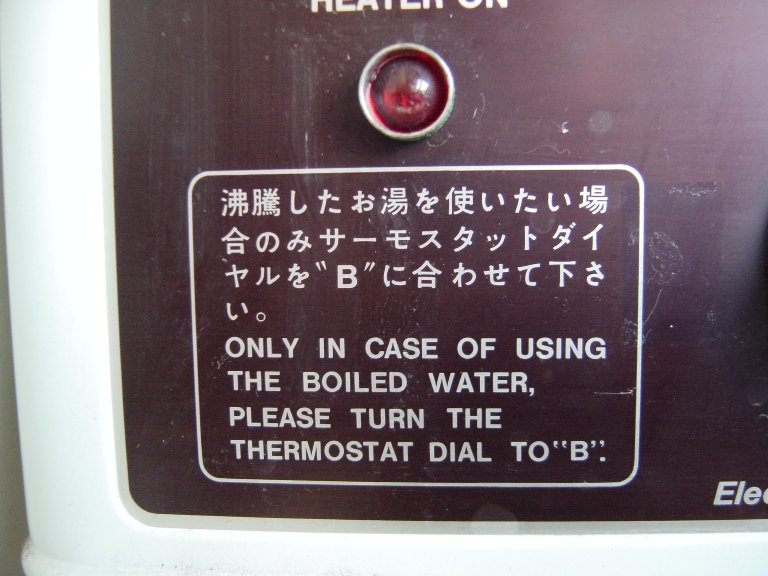Boiling / boiled water
Language Log 2013-04-03
Hiroshi Kumamoto (a specialist in Middle Iranian, especially Khotanese) sent in the following photograph of the sign on a water boiler in the Department of Linguistics at Tokyo University:
Since I wrote about the Chinese penchant for hot water in two recent Language Log posts ("Opens the waterhouse; open water rooms" and "Water between"), naturally I was game to take on this specimen of a water heating apparatus from Japan.
The directions posted on the heater read as follows:
Futtō shita oyu o tsukaitai baai nomi sāmosutatto daiyaru o "B" ni awasete kudasai.
沸騰したお湯を使いたい場合のみサーモスタットダイヤルを"B"に合わせて下さい。
ONLY IN CASE OF USING THE BOILED WATER, PLEASE TURN THE THERMOSTAT DIAL TO "B".
I suppose one might interpret that to mean that, in all other cases (such as when you don't want to boil water), don't turn the dial to "B".
This is a fairly common problem in J-E / E-J translation: clause order is reversed, and a perfectly serviceable — if stilted or awkward — translation could be achieved simply by switching the clauses around. "Please turn the thermostat dial to 'B' only in case of using the boiled water" is pretty close to acceptable English. The translator has omitted the nicety of "wanting to", without which this version is never going to be better than "meh", but order change is definitely an improvement.
The English translation is surely not the most felicitous rendering that might be made of the Japanese. Here are some other possibilities:
"Only when you want to use boiling water, set the thermostat dial to 'B'."
"Turn the thermostat dial to 'B' only in the event that you would like to use hot water."
"Turn the thermostat dial to 'B' for hot water only."
"Turn the thermostat to 'B' when you want to boil water."
Notes:
1. futtō shiteiru 沸騰している ("boiling") and futtō shita 沸騰した ("boiled") share the same meaning in the pre-nominal position / relative clause in Japanese. This is probably why it was translated here as "boiled water" instead of "boiling water". In English, "boiling water" and "boiled water" do not mean the same thing.
yu 湯 ("hot water")
futtō shiteiru yu 沸騰している湯 ("hot water which is boiling")
futtō shita yu 沸騰した湯 ("hot water which has reached the boiling point")
The verbs which behave this way in Japanese are those whose resultant state lasts at least for a while after the action is completed, e.g.:
kiru 着る ("wear")
haku 穿く ("wear")
motsu 持つ ("hold")
2. The 騰 in futtō 沸騰 is a very complicated, difficult kanji with a total of 20 strokes. It is somewhat surprising that the government did not come up with a simplified version when they designated 1,850 tōyōkanji 当用漢字 ("kanji for general use").
3. One wonders whether this is the only way to indicate the device in Japanese:
sāmosutatto daiyaru サーモスタットダイヤル ("thermostat dial")
As to what prompted Hiroshi to send me the photograph of the directions affixed to the water boiler in his departmental office, he mentioned to me that he had to live with that sign for 24 years. Now that he is retiring, I can imagine that it is with a combination of amusement and bemusement that he felt the need to unburden himself of having to look at that sign for nearly a quarter of a century by sharing it with someone outside who would appreciate its subtle n yuansu ニュアンス ("nuances").
I would not want to close this post without mentioning that, upon his retirement after teaching in the Department of Linguistics at Tokyo University for nearly a quarter of a century, Hiroshi Kumamoto (Ph.D. University of Pennsylvania, 1982) was recently gifted with a magnificent Festschrift by his colleagues. This substantial Festschrift has papers on Indo-Aryan, Indo-Iranian, Pwo Karen, Kurux, Latin, Georgian, Arabic, Tocharian, Hittite, Japanese, English, Mongolian, Talaud, Sanskrit, Sogdian, and other interesting subjects.
[Thanks to Cecilia Segawa Seigle, Hiroko Sherry, and Nathan Hopson]
